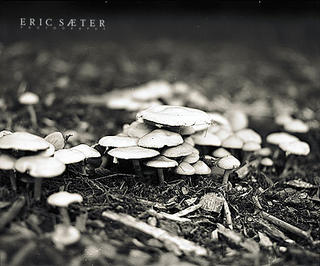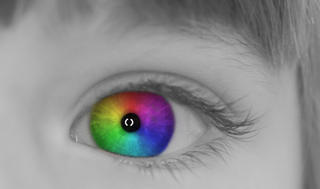Why Black and white?

(Picture courtesy - http://www.flickr.com/photos/ericsaeter)
In this day of pixels and printers, a time when a diminishing number of photographers relish the acerbic whiff of acetic acid stop bath, or the pungent smell of fixer, why black and white?
Why black and white, when colors are so brilliant and images so easily seductive? When digital manipulation has become the norm, and flash has ultimately diminished the appreciation of the exquisite, yet perhaps too subtle, tonal range of ambient light? Why Black and White?
Forgive my bias, but this seems to me a rhetorical question. The answers are many, and call me old fashioned, but black and white, the original art that inspired Sir John Herschel to coin the term "photography" drawing with light will always have a rightful place in the pantheon of legitimate art forms.
Because it's an easily learned technology although the best take years to master it and even a beginner can expose, develop and print his own images. Because few pleasures match that of watching an image slowly emerge on paper, beneath a red or amber safelight. 25 years ago the buyer of an old house found an abandoned trunk in the attic and carried it to the alley for the garbage men. I rummaged through it. Inside I found this sepia toned black and white portrait of an elegant woman, protected by a cardboard folio and accompanied by a studio receipt dated 1920.
25 years ago the buyer of an old house found an abandoned trunk in the attic and carried it to the alley for the garbage men. I rummaged through it. Inside I found this sepia toned black and white portrait of an elegant woman, protected by a cardboard folio and accompanied by a studio receipt dated 1920.
Dozens more heirloom family photos were in yellowing envelopes. I saved them all. Black and white photos survive time. --- Scott Kilborn
Because despite the claims for color printing products, as far as we know black and white prints last much longer than color. Because black and white has an inherent dignity. Because color, especially in the hands of an amateur how many photographs of sunsets have we seen, masquerading as "Art"? has the facile attraction of an easy woman. (Which may be why we see sunsets in so many advertisements.)
Black and White is both the simplest, and the most sophisticated of photographic disciplines. Shall we start at the beginning?
For most, an introductory photography class includes exposure although most contemporary cameras are so technically advanced as to preclude the necessity of a very deep understanding of the relationship between f. stop and exposure time development (learning how sensitive and capable our fingers can be in total darkness is a discovery bordering on epiphany for some); and then, the creation of work on paper: contact prints and enlargements.
To me, this is the equivalent of learning to draw in an art class: After you've mastered the basics, you may take this proficiency where you will, but it's a pre-requisite of making informed art.
As one progresses, one simple step at a time, one learns how to expose for specific anomalous situations: To adjust for backlit scenes, or over-expose in situations snow, for example where the reflective meter isn't accurate. To expose to put a specific shade of gray, and the entire tonal range, where one desires.
Black and white practitioners learn the use of filters to change the tone of different colors as recorded on the black and white negative.
All this within the context of the fact that black and white negative film has immense exposure latitude, putting good images within the reach of even the rankest amateur.
In black and white photography, contrast control through development is fairly simple: overexpose and shorten development time (pull) to diminish contrast. And the reverse to increase contrast.
No experienced photographer would argue for a second that making good enlargements is easy, but with a good negative, it isn't hard.
(As a technical aside, I think it's only fair to warn against allegedly "black and white" films that are processed using C-41 chemistry. Chromogenic "B&W" films may be convenient for those who don't or can't process themselves, or don't have easy access to a black and white lab, but no "black and white film" processed by your local one hour mini-lab using color negative chemicals will match the tonal range and accuracy of legitimate black and white film.)
None of which is to claim that black and white is inherently a "better" medium than color photography. It's just different.
Admittedly, there are subjects for which color is more appropriate. Sports, for instance. Some landscapes, although it's easy for color to overwhelm. Few color landscape photographers have matched the work of Ansel Adams and Edward Weston, for example.
And it's more than arguable that black and white is at it's best for people photography, and specifically portraiture. From early portraits by Julia Margaret Cameron, and later, Steiglitz and Steichen, early fashion, the WPA photographers who documented American life during the depression, to a whole slew of great Hollywood glamour photographers in the '30s and '40s, and all the masters that made Life magazine perhaps the best periodical of its era.
Not to mention Paul Strand and August Sander. Margaret Bourke-White and Imogene Cunningham. Kertész, Lartigue and Demarchy. Horst and Karsh. Bill Klein and Robert Frank. Bruce Weber and Herb Ritts.
Look... I'm not for a second about to argue what is or is not Art. I'm as baffled as the next person when I walk into a contemporary gallery.
But as to art photography, one of the early, and probably still strong arguments against color, is the fact that it just doesn't last. Opinions aren't so adamant now. Type C color prints have become common in artistic circles.
Even though the early claims concerning the archival characteristics of Ciba/Ilfochrome prints now seem exaggerated, and at least one manufacturer of color printing paper has the audacity to name its paper "... Archive," we just don't know how long color prints and negatives will last before fading.
Am I the only photographer who would like his images to be around after he's dead?
Finally, as a working photographer I'm and I'll admit it obsessed with two aspects of the camera's ability to create images: Photography can capture beauty, and it can stop time.
As often as not, black and white is the best way to capture beauty and stop time.
(Courtesy - www.acecam.com - commentary by Robert Bruce Duncan)



